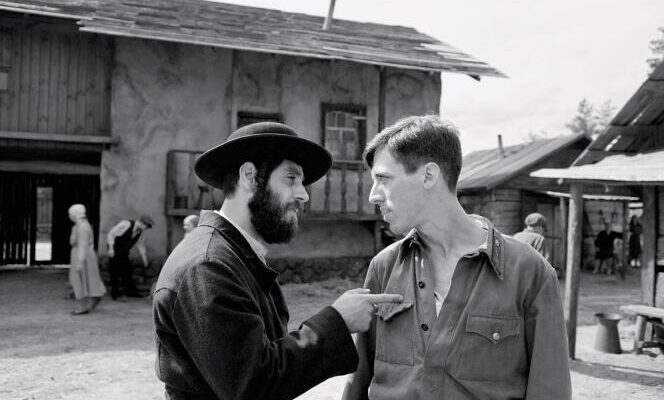Just read the introduction to Shttl to understand that Ady Walter’s first film, in theaters on December 13, takes us on the trail of a painful page from the past: it is June 21, 1941, the eve of the invasion of the Ukrainian Soviet Socialist Republic by the Nazis. More tragically, the camera lands in a shtetl, these Jewish villages already disappearing in this part of central Europe, due to the Soviet collectivization policy, while a young man returns to the village of his childhood , leaving Moscow where he studied cinema. Through this character, the film shows the tensions between religious Jews and secularists, seduced by the promise of communism.
Shttl is filmed in Yiddish, a language that two thirds of Jews still spoke at the start of the Second World War, i.e. eleven million speakers, the majority swallowed up by the Shoah. It is therefore this world that has disappeared, body and property, including its murdered language, that manages to reconstitute Shttl in a striking way. Here, it is not the language of the deceased that the spectator hears, but a living language, recorded in its last tremors, without the awareness of this inevitability.
The title of the film has a programmatic value. Ady Walter deliberately omitted the “e”, in homage to the novel by Georges Perec Disappearance (Gallimard, 1969), where the author, whose mother was deported to Auschwitz, had voluntarily deprived himself in his text of the most used letter in the French language to symbolize the handicap of a writing forever amputated . Shttl So move forward on one leg.
Filming under threat of Russian invasion
This intimate relationship with the question of transmission is at the very heart of the narrative principle of the film. As Ady Walter explains, “It all revolves around the main character, who returns home and finds himself caught up in the story. To what extent should we free ourselves from it? How far does he remain faithful to him? »
Beyond this fiction, the filming of Shttl could have been the subject of a film in its own right. The director, author of several documentaries, had completed his script at the beginning of 2019, for filming planned in Ukraine, the only country where it seemed possible to film his story. If rural Judaism has disappeared from the country, there remains an intense Jewish life in kyiv. The start of filming, scheduled for 2020, was initially delayed by a year due to Covid-19.
In the summer of 2021, it can finally start. Around thirty wooden houses are rebuilt, a synagogue entirely hand painted, decorated for several weeks, in order to recreate the shtetl from the film, knowing that almost all the Jewish village communities that existed in Ukraine were destroyed during the Second World War . The village is built on the edge of the “Kievian Sea”, a giant artificial lake, one hour from kyiv.
You have 45% of this article left to read. The rest is reserved for subscribers.
